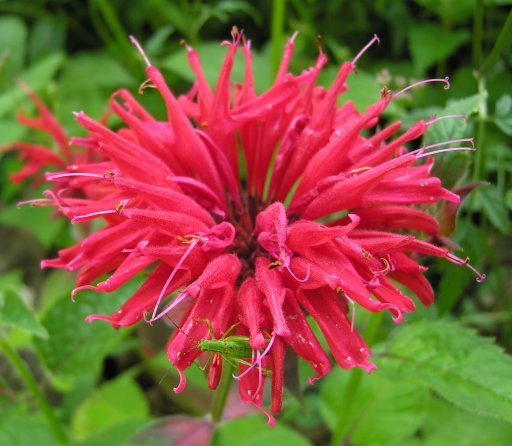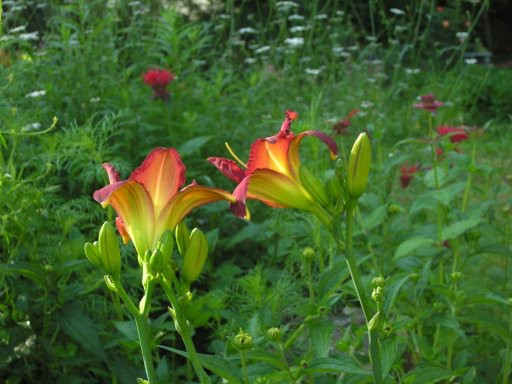One of the great things about waking pre-dawn is the glorious early-morning light; and one of the great things about photographing gardens is that you can zero in one one or two flowers that look splendid, and crop and blur out all the rest (i.e. 98%) that doesn't look so hot.
I love color—bright color, dull tones, delicate tints—but the days of listing red as my favorite (kindergarten) are long gone. Nonetheless, in the right conditions I can get enthusiastic about any color, and what is more appropriate for July, with heat and holiday that both claim red as a banner color?

I'm not sure what these green bugs are, but I noticed two of my monarda blooms were decorated with them, which probably means they're a garden pest. Oh well.
I have two kinds of monarda, red ones and magenta ones. What I really want are the scarlet ones, the blue-red ones between these two colors, as a transition. (Of course, I'd love some of the blue-violet ones too, since purple rules.) The red ones are bigger: taller, with larger blossoms. —Now as it happens, I probably have a dozen kinds of daylilies, including at least three red varieties—the wine-red ones shown below; a true-red with the same shaped flower; and a small, sharp-blossomed kind with sharp orangey red color.
Fortunately for me, there is a fair overlap between gardeners and beadmakers, and one of my beady friends is also a daylily enthusiast, who has generously given me many different kinds. I love having so many variations on a theme, but even if I just had the traditional orange ones, I'd still really enjoy daylilies—the bold, graphic quality of the flowers, the wonderful branching stems, the dense linear foliage, the drought resistance, and the fact that they're relatively pest and disease free. They love sun but will grow in the part shade that dominates my yard.
Oh, how I especially love them in early morning light!
pix shot, and file created, all between 8 and 9:30, 08jul06; 18jul2020: split garden and 2006 tags; added more tags
Unless otherwise noted, text, image and objects depicted therein copyright 1996--present sylvus tarn.
Sylvus Tarn